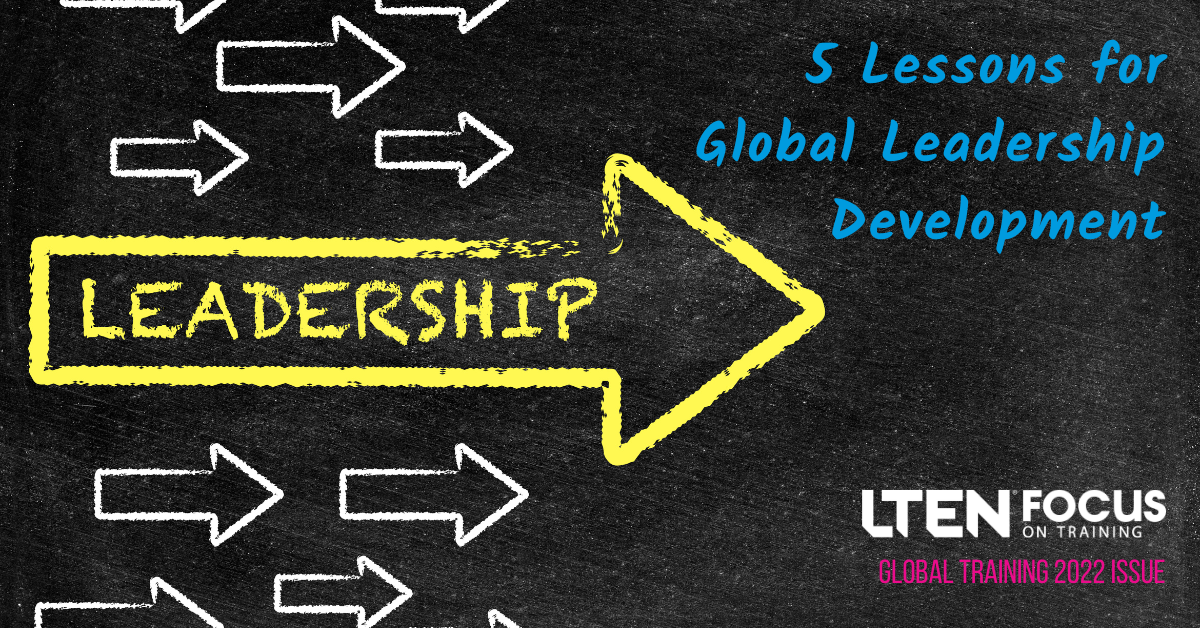
Feature Story – Wendy L. Heckelman, Ph.D.
The life sciences industry continues to face challenges from the ongoing disruption in the healthcare marketplace and escalating pricing pressures. Like almost every industry, hybrid work environments and other changes continue to reshape the workplace and the very nature of work.
Fundamentally, leaders at all levels and in all markets must learn to thrive during change and contribute to reshaping the future. As executives reimagine the future of their organizations, there must be a strong commitment to redefining leadership competencies, enhancing leadership development initiatives and globally deploying these efforts with sensitivity to existing cultural differences and emerging workplace changes.
Designing and deploying a global leadership development program is a large-scale change effort. This article highlights several lessons and best practices from companies that have been through this journey, which you can apply within your organizations.
Lesson 1: Articulate a leadership development philosophy.
Companies with strong alignment among senior leadership on the importance of leadership development, and who scale their investment to match their intent, develop deeper benches, retain more talent and typically outperform their competition. Sustained commitment from senior leadership – along with clear accountabilities for executing leadership development by all people managers, HR, learning and organizational – are essential elements of a sound leadership development philosophy.
Lesson 2: Clearly define and update leadership competencies to reflect the evolving marketplace.
While leadership definitions may vary, it is essential that organizations clearly define and articulate leadership principles and specific behaviors and reinforce the importance of “how” individuals behave and lead others. Below are some examples of critical and newly emerging behaviors needed in the life sciences industries:
- Thriving through ongoing change, demonstrating agility and readying leaders to effectively execute during times of change.
- Defining, creating and reinforcing a cultural environment conducive to innovation, inclusion and development.
- Enhancing cross-functional effectiveness through better collaboration, coordination and communication.
- Thinking strategically to better understand and anticipate evolving marketplace trends, then reshaping and redirecting priorities accordingly.
Lesson 3: Strategically design your organizational culture around company values.
Appropriately designed and deployed global leadership development efforts complement cultural initiatives and efforts. However, it is important to remember that tensions may exist between how a company defines its corporate culture and the unique cultural norms and practices in different functional areas, business units or countries.
Therefore, anchoring company values in all leadership development efforts is essential for driving common understanding and commitment. Organizations that use company values to reinforce their culture and commitment to learning, development and inclusion cultivate higher levels of engagement, better retention and stronger performance.
Lesson 4: Remember “Glocalization.”
“Glocalization” in a marketing context is the practice of conducting business with both local and global considerations. For example, McDonalds offers products unique to local tastes, yet may still maintain elements of its core offerings.
For life sciences companies, even when certain products may not vary, local marketing efforts are customized to address unique regulatory requirements, healthcare delivery practices and cultural norms. This concept of adapting marketing practices for local markets should also be applied to leadership development efforts.
“Global” leadership development begins with defining what is core, common and critical.
“Core” refers to elements such as values, policy and corporate strategy, which apply company-wide.
“Common” may include leadership behaviors that should be consistent across markets. Lastly, “Critical” includes knowledge, skills and capabilities necessary for success in a specific business and industry.
As an example of what is core, common and critical, many leadership development practices use a common framework for coaching others. Even these “global” models or frameworks must recognize differences and allow for local adaptation, as needed.
Leadership development localization should recognize unique cultural practices and norms when designing and deploying programs and materials. This may include how various cultures relate to thought patterns, time, communication style and formality. For example, some cultures value speed in decision-making while others may require more discussion, socialization and consensus.
When designing leadership programs for global rollout, account for these differences when creating case study scenarios and facilitating workshop discussions. Consider logistical adaptations, such as time allocation for various activities and exercises to allow for more discussion and relationship building when cultural practices or language differences dictate.
Guidance should be provided to local learning professionals on when and how to best adapt exercises or on-the-job applications to fit their clients’ needs and marketplace differences. This improves sustainability and pushes accountability for effectiveness down to the local market.
Lesson 5: Invest more time up front in building stakeholder commitment when executing a global leadership development initiative.
A global rollout requires keeping the end in mind. Global learning teams should actively engage and involve stakeholders and subject matter experts from around the world to build commitment and ensure program applicability. Be sure to consider execution requirements from train-the-trainers to allow time for language translation of materials.
Differences in learning management system platforms may also slow down deployment. As one learning leader shared, “When deploying a global leadership development initiative, invest more time up front in localizing your content and building stakeholder commitment. Go slow and be thorough during preparation to gain speed and enhance effectiveness during execution.”
Summary
In the complex life sciences industries, where so much is at stake bringing critical medicines and solutions to patients, providers and caretakers, effective leadership development practices enhance achievement of critical organizational goals.
These five lessons represent important opportunities for learning professionals to exhibit strong partnership with their organizations by ensuring leaders and employees at all levels understand their respective roles and responsibilities and can easily access tools, resources and learning assets. An effective global approach includes the core, common and critical, but allows for adaptation to fit local practices and needs.
Wendy L. Heckelman, Ph.D., is founder and president of WLH Consulting and Learning Solutions. Email Wendy at wendy@wlhconsulting.com.









